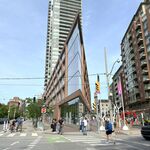TOareaFan
Superstar
No, I think the point is that the current airport is a poor use of valuable public assets. Beyond all of the obvious reasons why this is not compatible with other land uses in the general area (recreation, cultural, schools residential bird sanctuary), it is a very poor economical use of a valuable public asset. Not only does it not make money for the city, it actually costs the city...millions.
The TPA has no interest in what is good for Toronto....their interest in increasing business at the airport is that it might start making money for them, and possibly meet their mandate as a Federal Port Authority to be economically self-sufficient, which they aren't. Which is another good reason why the TPA should be dissolved.
Again, then, what is the better use that unlocks this "$2B" in value to the city?
Then you should petition the City to stop planting trees.
Or...perhaps you missed the point
That is not the conclusion that I would reach from my statement....I would suggest that if there is a foundation for showing that the trees produce/save $60 million and that is the basis for assigning a financial value on the trees....it would produce a much lower value than $7B.
That does not mean trees have no value (outside of economic value) but it does mean if you are going to use financial/numeric metrics on something like trees...they better have some basis in reality.




